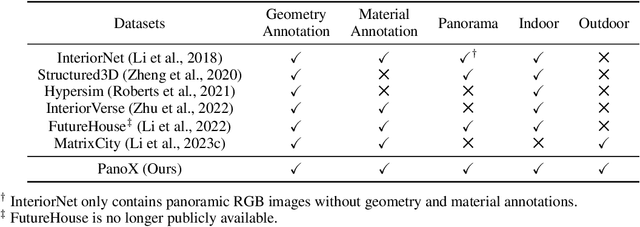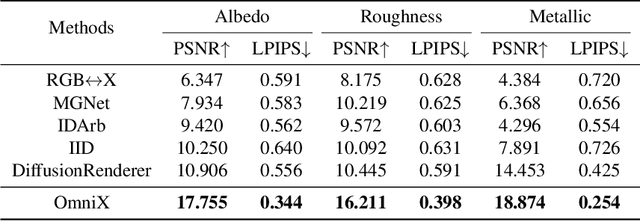Xintao Wang
GARDO: Reinforcing Diffusion Models without Reward Hacking
Dec 30, 2025Abstract:Fine-tuning diffusion models via online reinforcement learning (RL) has shown great potential for enhancing text-to-image alignment. However, since precisely specifying a ground-truth objective for visual tasks remains challenging, the models are often optimized using a proxy reward that only partially captures the true goal. This mismatch often leads to reward hacking, where proxy scores increase while real image quality deteriorates and generation diversity collapses. While common solutions add regularization against the reference policy to prevent reward hacking, they compromise sample efficiency and impede the exploration of novel, high-reward regions, as the reference policy is usually sub-optimal. To address the competing demands of sample efficiency, effective exploration, and mitigation of reward hacking, we propose Gated and Adaptive Regularization with Diversity-aware Optimization (GARDO), a versatile framework compatible with various RL algorithms. Our key insight is that regularization need not be applied universally; instead, it is highly effective to selectively penalize a subset of samples that exhibit high uncertainty. To address the exploration challenge, GARDO introduces an adaptive regularization mechanism wherein the reference model is periodically updated to match the capabilities of the online policy, ensuring a relevant regularization target. To address the mode collapse issue in RL, GARDO amplifies the rewards for high-quality samples that also exhibit high diversity, encouraging mode coverage without destabilizing the optimization process. Extensive experiments across diverse proxy rewards and hold-out unseen metrics consistently show that GARDO mitigates reward hacking and enhances generation diversity without sacrificing sample efficiency or exploration, highlighting its effectiveness and robustness.
SemanticGen: Video Generation in Semantic Space
Dec 24, 2025Abstract:State-of-the-art video generative models typically learn the distribution of video latents in the VAE space and map them to pixels using a VAE decoder. While this approach can generate high-quality videos, it suffers from slow convergence and is computationally expensive when generating long videos. In this paper, we introduce SemanticGen, a novel solution to address these limitations by generating videos in the semantic space. Our main insight is that, due to the inherent redundancy in videos, the generation process should begin in a compact, high-level semantic space for global planning, followed by the addition of high-frequency details, rather than directly modeling a vast set of low-level video tokens using bi-directional attention. SemanticGen adopts a two-stage generation process. In the first stage, a diffusion model generates compact semantic video features, which define the global layout of the video. In the second stage, another diffusion model generates VAE latents conditioned on these semantic features to produce the final output. We observe that generation in the semantic space leads to faster convergence compared to the VAE latent space. Our method is also effective and computationally efficient when extended to long video generation. Extensive experiments demonstrate that SemanticGen produces high-quality videos and outperforms state-of-the-art approaches and strong baselines.
Visual-Aware CoT: Achieving High-Fidelity Visual Consistency in Unified Models
Dec 22, 2025Abstract:Recently, the introduction of Chain-of-Thought (CoT) has largely improved the generation ability of unified models. However, it is observed that the current thinking process during generation mainly focuses on the text consistency with the text prompt, ignoring the \textbf{visual context consistency} with the visual reference images during the multi-modal generation, e.g., multi-reference generation. The lack of such consistency results in the failure in maintaining key visual features (like human ID, object attribute, style). To this end, we integrate the visual context consistency into the reasoning of unified models, explicitly motivating the model to sustain such consistency by 1) Adaptive Visual Planning: generating structured visual check list to figure out the visual element of needed consistency keeping, and 2) Iterative Visual Correction: performing self-reflection with the guidance of check lists and refining the generated result in an iterative manner. To achieve this, we use supervised finetuning to teach the model how to plan the visual checking, conduct self-reflection and self-refinement, and use flow-GRPO to further enhance the visual consistency through a customized visual checking reward. The experiments show that our method outperforms both zero-shot unified models and those with text CoTs in multi-modal generation, demonstrating higher visual context consistency.
In-Context Audio Control of Video Diffusion Transformers
Dec 21, 2025Abstract:Recent advancements in video generation have seen a shift towards unified, transformer-based foundation models that can handle multiple conditional inputs in-context. However, these models have primarily focused on modalities like text, images, and depth maps, while strictly time-synchronous signals like audio have been underexplored. This paper introduces In-Context Audio Control of video diffusion transformers (ICAC), a framework that investigates the integration of audio signals for speech-driven video generation within a unified full-attention architecture, akin to FullDiT. We systematically explore three distinct mechanisms for injecting audio conditions: standard cross-attention, 2D self-attention, and unified 3D self-attention. Our findings reveal that while 3D attention offers the highest potential for capturing spatio-temporal audio-visual correlations, it presents significant training challenges. To overcome this, we propose a Masked 3D Attention mechanism that constrains the attention pattern to enforce temporal alignment, enabling stable training and superior performance. Our experiments demonstrate that this approach achieves strong lip synchronization and video quality, conditioned on an audio stream and reference images.
Kling-Omni Technical Report
Dec 18, 2025Abstract:We present Kling-Omni, a generalist generative framework designed to synthesize high-fidelity videos directly from multimodal visual language inputs. Adopting an end-to-end perspective, Kling-Omni bridges the functional separation among diverse video generation, editing, and intelligent reasoning tasks, integrating them into a holistic system. Unlike disjointed pipeline approaches, Kling-Omni supports a diverse range of user inputs, including text instructions, reference images, and video contexts, processing them into a unified multimodal representation to deliver cinematic-quality and highly-intelligent video content creation. To support these capabilities, we constructed a comprehensive data system that serves as the foundation for multimodal video creation. The framework is further empowered by efficient large-scale pre-training strategies and infrastructure optimizations for inference. Comprehensive evaluations reveal that Kling-Omni demonstrates exceptional capabilities in in-context generation, reasoning-based editing, and multimodal instruction following. Moving beyond a content creation tool, we believe Kling-Omni is a pivotal advancement toward multimodal world simulators capable of perceiving, reasoning, generating and interacting with the dynamic and complex worlds.
SVG-T2I: Scaling Up Text-to-Image Latent Diffusion Model Without Variational Autoencoder
Dec 12, 2025Abstract:Visual generation grounded in Visual Foundation Model (VFM) representations offers a highly promising unified pathway for integrating visual understanding, perception, and generation. Despite this potential, training large-scale text-to-image diffusion models entirely within the VFM representation space remains largely unexplored. To bridge this gap, we scale the SVG (Self-supervised representations for Visual Generation) framework, proposing SVG-T2I to support high-quality text-to-image synthesis directly in the VFM feature domain. By leveraging a standard text-to-image diffusion pipeline, SVG-T2I achieves competitive performance, reaching 0.75 on GenEval and 85.78 on DPG-Bench. This performance validates the intrinsic representational power of VFMs for generative tasks. We fully open-source the project, including the autoencoder and generation model, together with their training, inference, evaluation pipelines, and pre-trained weights, to facilitate further research in representation-driven visual generation.
MVU-Eval: Towards Multi-Video Understanding Evaluation for Multimodal LLMs
Nov 13, 2025



Abstract:The advent of Multimodal Large Language Models (MLLMs) has expanded AI capabilities to visual modalities, yet existing evaluation benchmarks remain limited to single-video understanding, overlooking the critical need for multi-video understanding in real-world scenarios (e.g., sports analytics and autonomous driving). To address this significant gap, we introduce MVU-Eval, the first comprehensive benchmark for evaluating Multi-Video Understanding for MLLMs. Specifically, our MVU-Eval mainly assesses eight core competencies through 1,824 meticulously curated question-answer pairs spanning 4,959 videos from diverse domains, addressing both fundamental perception tasks and high-order reasoning tasks. These capabilities are rigorously aligned with real-world applications such as multi-sensor synthesis in autonomous systems and cross-angle sports analytics. Through extensive evaluation of state-of-the-art open-source and closed-source models, we reveal significant performance discrepancies and limitations in current MLLMs' ability to perform understanding across multiple videos. The benchmark will be made publicly available to foster future research.
Simulating the Visual World with Artificial Intelligence: A Roadmap
Nov 11, 2025Abstract:The landscape of video generation is shifting, from a focus on generating visually appealing clips to building virtual environments that support interaction and maintain physical plausibility. These developments point toward the emergence of video foundation models that function not only as visual generators but also as implicit world models, models that simulate the physical dynamics, agent-environment interactions, and task planning that govern real or imagined worlds. This survey provides a systematic overview of this evolution, conceptualizing modern video foundation models as the combination of two core components: an implicit world model and a video renderer. The world model encodes structured knowledge about the world, including physical laws, interaction dynamics, and agent behavior. It serves as a latent simulation engine that enables coherent visual reasoning, long-term temporal consistency, and goal-driven planning. The video renderer transforms this latent simulation into realistic visual observations, effectively producing videos as a "window" into the simulated world. We trace the progression of video generation through four generations, in which the core capabilities advance step by step, ultimately culminating in a world model, built upon a video generation model, that embodies intrinsic physical plausibility, real-time multimodal interaction, and planning capabilities spanning multiple spatiotemporal scales. For each generation, we define its core characteristics, highlight representative works, and examine their application domains such as robotics, autonomous driving, and interactive gaming. Finally, we discuss open challenges and design principles for next-generation world models, including the role of agent intelligence in shaping and evaluating these systems. An up-to-date list of related works is maintained at this link.
RelightMaster: Precise Video Relighting with Multi-plane Light Images
Nov 09, 2025Abstract:Recent advances in diffusion models enable high-quality video generation and editing, but precise relighting with consistent video contents, which is critical for shaping scene atmosphere and viewer attention, remains unexplored. Mainstream text-to-video (T2V) models lack fine-grained lighting control due to text's inherent limitation in describing lighting details and insufficient pre-training on lighting-related prompts. Additionally, constructing high-quality relighting training data is challenging, as real-world controllable lighting data is scarce. To address these issues, we propose RelightMaster, a novel framework for accurate and controllable video relighting. First, we build RelightVideo, the first dataset with identical dynamic content under varying precise lighting conditions based on the Unreal Engine. Then, we introduce Multi-plane Light Image (MPLI), a novel visual prompt inspired by Multi-Plane Image (MPI). MPLI models lighting via K depth-aligned planes, representing 3D light source positions, intensities, and colors while supporting multi-source scenarios and generalizing to unseen light setups. Third, we design a Light Image Adapter that seamlessly injects MPLI into pre-trained Video Diffusion Transformers (DiT): it compresses MPLI via a pre-trained Video VAE and injects latent light features into DiT blocks, leveraging the base model's generative prior without catastrophic forgetting. Experiments show that RelightMaster generates physically plausible lighting and shadows and preserves original scene content. Demos are available at https://wkbian.github.io/Projects/RelightMaster/.
OmniX: From Unified Panoramic Generation and Perception to Graphics-Ready 3D Scenes
Oct 30, 2025



Abstract:There are two prevalent ways to constructing 3D scenes: procedural generation and 2D lifting. Among them, panorama-based 2D lifting has emerged as a promising technique, leveraging powerful 2D generative priors to produce immersive, realistic, and diverse 3D environments. In this work, we advance this technique to generate graphics-ready 3D scenes suitable for physically based rendering (PBR), relighting, and simulation. Our key insight is to repurpose 2D generative models for panoramic perception of geometry, textures, and PBR materials. Unlike existing 2D lifting approaches that emphasize appearance generation and ignore the perception of intrinsic properties, we present OmniX, a versatile and unified framework. Based on a lightweight and efficient cross-modal adapter structure, OmniX reuses 2D generative priors for a broad range of panoramic vision tasks, including panoramic perception, generation, and completion. Furthermore, we construct a large-scale synthetic panorama dataset containing high-quality multimodal panoramas from diverse indoor and outdoor scenes. Extensive experiments demonstrate the effectiveness of our model in panoramic visual perception and graphics-ready 3D scene generation, opening new possibilities for immersive and physically realistic virtual world generation.
 Add to Chrome
Add to Chrome Add to Firefox
Add to Firefox Add to Edge
Add to Edge